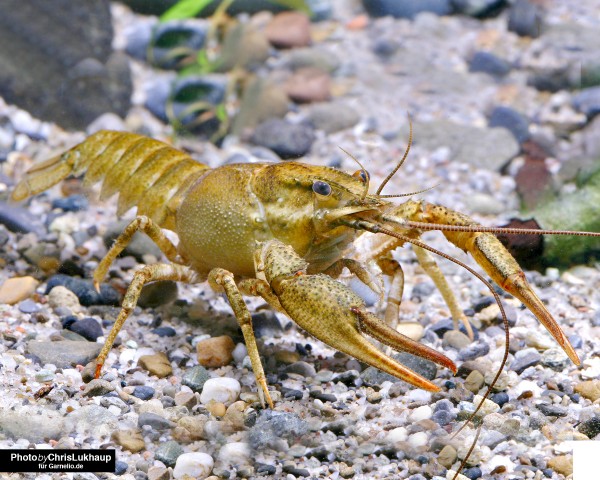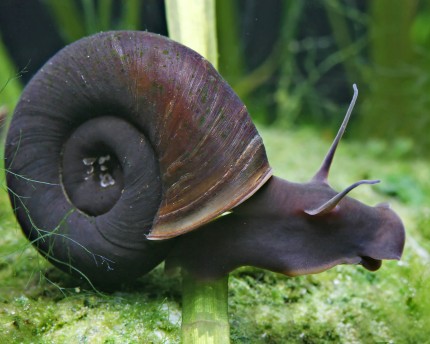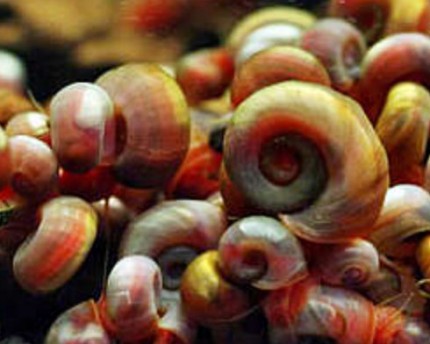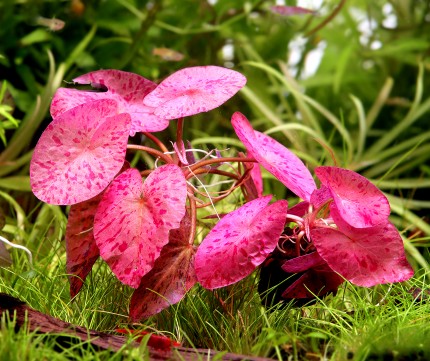Galician swamp crayfish - Pontastacus leptodactylus
- Item no: 5925
Fast delivery times
All products are in stock with us!14 years of breeding experience
Let our team of experts advise you!High customer satisfaction
from over 3,000 reviews "The pretty Galician swamp crayfish, scientifically also called the Pontastacus leptodactylus originates from areas around the Caspian Sea and the Black Sea. In the wild its populations are now endangered due to the deadly crayfish plague, originally it was also released into the wild in Europe.
In the garden pond this scissor-bearer cuts a fine figure, since it shows in places not only simply a brown-yellow to green carapace color, but now and then also one going into the bluish. With almost 18 centimeters the males become quite large, they can reach in places even 25 cm. Their claws are significantly longer and lack furrows, they also have "mating styli". Females remain somewhat smaller, and their claws are also much narrower. The carapace of the animals has spines. Galician swamp crayfish live about 6 years if well cared for.
But not only because of their appearance, they are welcome pond dwellers. With its preference for decomposing organic material, whether dead animals or even dead plant remains, it helps keep the pond clean, thus promoting the biological balance and keeping it from tipping over. Especially in the fall, when too much foliage falls into the pond, this "foliage destroyer" actively helps remove it.
Galician swamp crayfish are extremely easy to care for and keep, as they are quite undemanding. It copes well with warmer, stagnant to weakly moving and even waters. In addition it is somewhat more tolerant of pollution than other species. Even though it can actually be assumed that Galicans meet their food requirements with what they find in the pond, they should be overfed if necessary. For this purpose, commercially available sinking food is suitable, but also scalded vegetables.
The garden pond for Galician swamp crayfish should be absolutely safe from frost and therefore have a depth of at least one meter. It is relatively easy to ensure that the surface of the pond does not freeze over by means of floating icebreakers, but also by means of outflow stones or pond heaters, so that gas exchange is guaranteed in any case. Likewise, digging possibilities, but also hiding places in the form of caves should be available. It also stays in the weedy shore areas and digs living caves in places. Roots can also be used to create a good infrastructure to accommodate the animals.
Pontastacus leptodactylus can also be kept in groups in the pond without any problems, as they get along excellently. Their mating season falls mainly in the fall, when temperatures are around 10 to 12 degrees and takes place mainly at dusk. For almost two weeks the female carries about 200 eggs under her swimming legs. From these eggs hatch fully developed juveniles, which are almost miniature versions of their parents and remain under the swimming legs for a while before they venture into the open water. An overpopulation is not to be feared, however, since natural predators keep the number of young in check.
In aquariums with an edge length of 100 cm or more, the crepuscular crayfish should be kept escape-proof, a cover is a must! During the day it stays rather hidden. The substrate consists preferably of sand, because he digs in it for food. Therefore a socialization with other invertebrates is rather not suitable, since these are on its menu.
As an omnivore, the Galician Swamp Crayfish likes to nibble on worms and leeches it finds in the soil, but also insects, their larvae and other dead material, including dead plant remains, leaves and foliage.
Our food recommendation: Freshwater crayfish have a varied diet in the wild. The Natureholic Crab Feed Sticks contain in biologically balanced form only those components which these crayfish count in this or similar form to their natural food spectrum. This naturally supports and promotes moulting, growth and reproduction. Due to their protein content they are ideally suited for omnivorous crayfish of the genera Procambarus, Cambarus, Cambarellus, Astacus and the Cherax crayfish from Australia, which are basically omnivores that like to eat animal as well as vegetable food. The crayfish of the genus Cherax from Papua also like to eat a portion of animal food when they are young, but later they switch mainly to plant food.
Our plant recommendation: Use the following for planting NatureHolic InVitros. These are free of snails, planarians and other unwanted co-inhabitants. Also free of algae spores, bacteria and fungi.
Expert Tip: We recommend for fish keeping the NatureHolic 3 Phase Liquid. The care set offers the best all-round protection for your animals. It ensures optimal conditions for successful breeding and keeping.
| Scientific name: | Pontstacus leptodactylus |
| German name: | Galician swamp crayfish |
| Difficulty level: | for beginners |
| Origin/Distribution: | Central Europe |
| Coloration: | sand-colored to brown, but also green and occasionally blue |
| Age expectancy | approx. 5-6 years |
| Water parameters: | GH 5 to 25, KH 5 to 20, pH 6 to 8.5, temperature 4 to 20 °C |
| Tank size: | from 100 l for a pair, in groups in a pond from 5,000 liters |
| Food | Omnivorous: algae and growth, organic material, foliage, greens and vegetables |
| Breeding | easy, after 2 weeks about 200 young hatch |
| Behavior | little aggressive, compatible |
| Further information | Sex differences crayfish, shrimp, crayfish, snails & mussels feed properly, Cherax aquarium crayfish - keeping in the aquarium |
- Item no: 5925
Entdecke die Garnelio Welt!
Garnelio gehört zu den größten Onlineshops für wirbellose Aquarientiere weltweit.
Viele Artikel gibt es exklusiv nur bei uns im Shop.





































